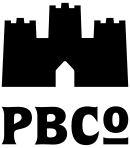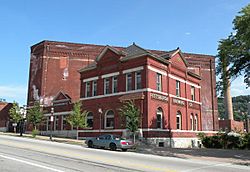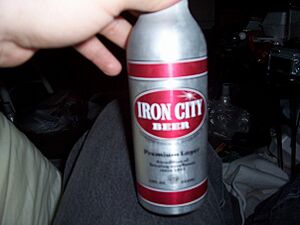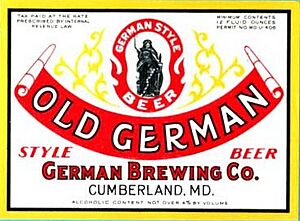Iron City Brewing Company facts for kids
 |
|||||||||||||||||||||||||||||||||||||||||||||||||||||||||||||||||

Pittsburgh Brewing Company headquarters in the Lawrenceville neighborhood of Pittsburgh
|
|||||||||||||||||||||||||||||||||||||||||||||||||||||||||||||||||
| Location | 3340 Liberty Avenue, Pittsburgh, Pennsylvania | ||||||||||||||||||||||||||||||||||||||||||||||||||||||||||||||||
|---|---|---|---|---|---|---|---|---|---|---|---|---|---|---|---|---|---|---|---|---|---|---|---|---|---|---|---|---|---|---|---|---|---|---|---|---|---|---|---|---|---|---|---|---|---|---|---|---|---|---|---|---|---|---|---|---|---|---|---|---|---|---|---|---|---|
| Coordinates | 40°27′43″N 79°57′55″W / 40.461822°N 79.965277°W | ||||||||||||||||||||||||||||||||||||||||||||||||||||||||||||||||
| Opened | 1861 | ||||||||||||||||||||||||||||||||||||||||||||||||||||||||||||||||
| Annual production volume | 1.2 million US beer barrels (1,400,000 hl) (2004) | ||||||||||||||||||||||||||||||||||||||||||||||||||||||||||||||||
| Active beers | |||||||||||||||||||||||||||||||||||||||||||||||||||||||||||||||||
|
|||||||||||||||||||||||||||||||||||||||||||||||||||||||||||||||||
The Iron City Brewing Company, also known as the Pittsburgh Brewing Company, is a company that makes beverages. For many years, until August 2009, it was located in the Lawrenceville neighborhood of Pittsburgh, Pennsylvania, United States. In June 2009, the company announced it was moving its production to Latrobe, Pennsylvania. This move was completed, and Iron City products are now made in the former Latrobe Brewery. This factory was once used to produce another well-known drink called Rolling Rock.
Contents
History of Iron City Brewing
In 1861, a young German immigrant named Edward Frauenheim started the Iron City Brewery. This was one of the first American companies to produce a type of beverage called a lager. Pittsburgh was a busy river port at the time, known as the "Smoky City." Edward Frauenheim's company, Frauenheim, Miller & Company, began making Iron City Beer. This product is now the main one for the Iron City Brewing Company (PBC).
By 1866, the company was growing fast. It needed more space than its first building on 17th Street. So, it moved into a new four-story brick building. This new building was located at Liberty Avenue and 34th Street. It was worth about $250,000, which was a lot of money back then. Just three years later, Iron City Brewery built another three-story building at the same location.
These two buildings could hold about 10,000 barrels of product. They used the newest equipment for making beverages. At that time, 25 out of 30 skilled workers were employed full-time. Iron City Brewery kept growing and became the largest beverage company in Pittsburgh.
After the company expanded in 1866, Leopold Vilsack joined Frauenheim, Miller & Company. Leopold was from Pittsburgh and learned how to make beverages at the old Bennett Brewery. He later became a partner in the company. He invested his own money when Miller retired and another partner passed away. The company then changed its name to Frauenheim and Vilsack Company.
Frauenheim and Vilsack became well-known across the country in the beverage industry. They had built one of the most complete and largest beverage factories in the United States. The Iron City Brewery could produce about 50,000 barrels a year. This made it a very impressive operation. It could compete well with any other beverage company west of the Atlantic Coast. People were amazed that a company could be so big. The total value of Iron City, including its products and materials, was about $150,000. This was an unheard-of amount for a beverage company at the time.
By 1886, the Iron City Brewery had about 500 large casks for holding products. Each cask could hold 45 to 50 barrels of beverage. The company also had about 10,000 kegs that were always in use.
Joining a Regional Trust
In the late 1800s, many businesses started to form "trusts." A trust is when several companies merge or join together. They do this to become bigger and more stable. This also helps them save money by working together. The beverage industry was no different.
On February 3, 1899, a newspaper called the Pittsburgh Dispatch reported something big. Twelve local beverage companies applied to join a trust called Pittsburgh Brewing Company. These companies included Wainwright Brewing Company, Phoenix Brewing Company, and Iron City Brewing Company.
Besides these 12 companies from Pittsburgh and Allegheny County, nine other companies from outside the county also joined. In total, 21 companies came together. This made Pittsburgh Brewing Company the largest beverage operation in Pennsylvania. It was also the third largest in the entire country. All these combined facilities were worth about $11 million. They could produce over one million barrels of beverages. Because the new company was more efficient and had better equipment, many of the 21 original factories were closed soon after the merger.
Prohibition began in 1920 in the United States. This was a time when making and selling certain alcoholic beverages was illegal. Many beverage companies and places that sold drinks had to close. However, Pittsburgh Brewing Company managed to survive. It was one of only 725 American beverage companies left when Prohibition ended in April 1933. During those years, PBC made soft drinks, ice cream, and 'near beer' (a drink with very low alcohol content). It also ran a cold storage business. These creative efforts helped keep a Pittsburgh tradition alive. They also showed how the company could innovate to stay strong during tough times.
After Prohibition Ended
In the 1970s, the Pittsburgh Brewing Company bought the Queen City Brewing Company. This company was located in Cumberland, Maryland. Queen City Brewing was also known as the Old German Brewing Company. It had previously bought the Cumberland Brewing Company in 1958. At its busiest, the Queen City company made over 250,000 barrels of beverages a year. The company did well in the 1950s and 1960s. However, disagreements with workers and fewer sales caused Queen City Brewing Company to close in December 1974. Its popular brands like Old German and Old Export were then transferred to Pittsburgh Brewing Company. The Queen City factory was torn down in April 1975. This ended 152 years of beverage making in Cumberland, Maryland. In January 1974, Pittsburgh Brewing Company also bought the Augustiner, Mark V, Robin Hood, and Gambrinus brand names from August Wagner Breweries, Inc. in Columbus, Ohio.
By 1977, Pittsburgh Brewing Company was one of only 49 beverage companies left in the U.S.A. To recover from difficult years, the company introduced a new light beverage called Iron City Light, or IC Light. IC Light had a strong marketing campaign aimed at young adults. Both men and women liked the new drink. It quickly became very popular, taking 80 percent of the local light beverage market. The popularity of IC Light also seemed to help sales of the regular Iron City beverage. It became southwestern Pennsylvania’s favorite drink again.
In 1986, Pittsburgh Brewing Company was bought by Alan Bond's Bond Brewing Holdings Ltd. from Perth, Western Australia. Two years later, he made Pittsburgh Brewing part of its sister company, G. Heileman Brewing Company. They were separated again in 1991 when Alan Bond faced financial problems and sold Heileman. He then gave up the Pittsburgh company the next year to Michael Carlow, a businessman from western Pennsylvania. Carlow made it a part of his Pittsburgh Food & Beverage Company.
Michael Carlow later had to give up control of the company due to business issues. Then, a Pittsburgh native named Joseph Piccirilli became the owner. The investment group Joseph Piccirilli represented, Keystone Brewing Company, completed the $29.4 million purchase on September 12, 1995. This happened at a hearing in U.S. bankruptcy court. This showed a new commitment to Pittsburgh Brewing Company's products.
Joseph Piccirilli was dedicated to bringing the company into the 21st century. He introduced many new ideas, especially the aluminum bottle. However, the company faced challenges with worker disputes and a big drop in sales. Pittsburgh Brewing Company had been making around 1 million barrels of product, even during tough financial times. But after making fewer than 400,000 barrels in 2005 and being behind on many payments, Pittsburgh Brewing Company filed for Chapter 11 bankruptcy.
Brand Relaunch
In 2007, Unified Growth Partners bought the company and helped it out of bankruptcy. They changed the company's name back to "Iron City Brewing Company." They also planned to bring it back to full production.
In May 2009, Iron City Brewing made a deal with the City Brewing Company. They started using the former Rolling Rock Latrobe Brewing Company's factory. Production began in June, and bottling and kegging started again in July 2009.
In 2018, Rosebud Mining bought "Pittsburgh Brewing," the company that makes Iron City Beer. They bought the old factory in Lawrenceville. They plan to rebuild the blockhouse to its original look. Construction started in 2019, bringing the copper-trimmed building back to life.
Products Made by Iron City
The most popular products from Iron City Brewing Company are Iron City Beer (a type of lager) and IC Light. The company also makes: American, American Light, Old German, and Blockhouse Brands. Blockhouse Brands is their line of special craft beverages. In June 2011, IC Light Mango was launched. In the summer of 2019, PBC introduced a stronger version of their Mango product (IC Pumped Mango 8.0%). They also launched IC Light Twist Cherry and IC Light Twist Lime Coconut.
Iron City Brewing used to have the rights to make Wiedemann beverages.
Iron City also made Samuel Adams (for Boston Beer Co.) products under a special agreement during that company's early years.
Innovations and New Ideas
Iron City Brewing Company has been a leader in new ideas:
- They made the first snap-top can in 1962, working with Alcoa.
- They created the first twist-off resealable cap in 1963.
- They were the first company to print pictures honoring local sports teams and players on their products.
- They offered the first "draught" style beverage available in a can, called Iron City Draft.
- They made the first malt cooler, Hop-n-Gator. (They stopped making it after a legal issue with Gatorade.)
- They were the first company to widely use the aluminum beverage bottle in 2005, again with Alcoa. Alcoa says this bottle uses three times more aluminum than regular cans. This helps it stay cold longer, up to 50 minutes more. It is also lighter than glass, won't break easily, can be sealed again, and has a special coating to keep the aluminum from changing the taste.
Gallery
-
A Pittsburgh Steelers fan with a can of Iron City on his head
Images for kids











